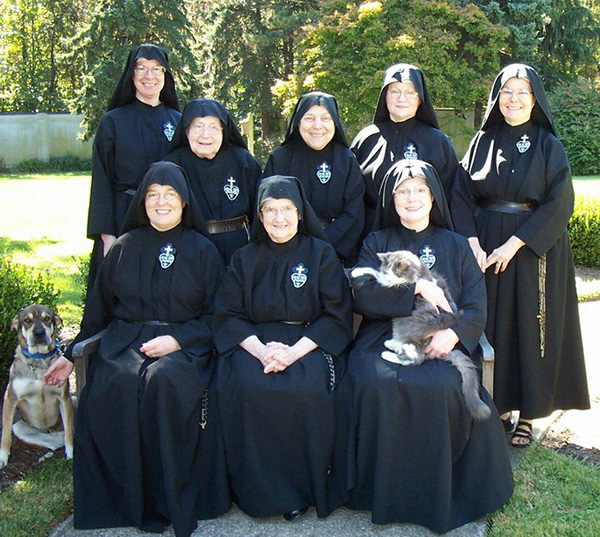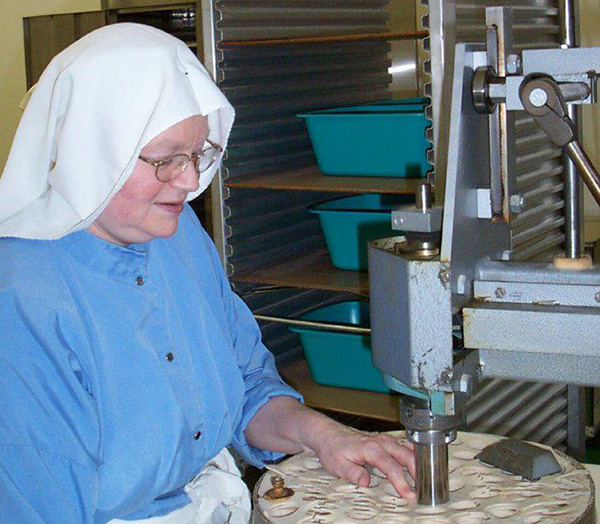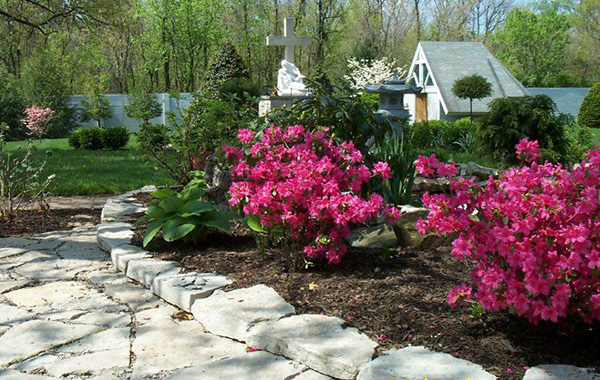Meet the Cloistered Nuns Who Bake Communion Bread


Great bakers are passionate about producing a quality product, but when the bakers are Passionist, “passion” is spelled with a capital P.
For 62 years, the cloistered nuns of the Passionist Monastery in Erlanger, Kentucky, have been baking altar bread for parishes across the country. Passionist spirituality is based on the Passion of Jesus Christ, and for these eight nuns, so is their labor. As Sister Angela explains in this charming video the sisters made for first communicants, “We help to bring Jesus to you, and that’s a part of our life.”
At 8:30 every morning except Sundays and Fridays, four nuns change out of their black Passionist robes into blue baking ones. They start their workday by mixing water and flour to make paste. Back in 1951 when the monastery began making altar bread, they measured flour and water with measuring cups. Now that the business has expanded to 100 parishes nationwide, they have to measure with scales.
The paste is ladled onto “bakers,” a machine similar to a waffle iron, except that instead of a grid, the Chi-Rho symbol is embossed onto the bread. Once the 14-inch plates are cooked, they’re stacked and stored overnight in a humidifier so they can be cut without breaking the next day. The moistened plates are assembled in stacks of 72 and cut into small and medium-sized wafers. Once cut, the wafers dry out in dish pans, to be packaged later by 91-year old Sister Paul for distribution.

Sr. Mary Angela cuts the wafers.
By one o’clock the nuns leave the kitchen, their work of producing 25,000 wafers mostly done. After lunch, prayers, and recreation, they return to the kitchen at 5:30 to finish.
It’s physically demanding work, especially considering that most of the bakers are elderly. The nuns work six baking machines at a time and power the cutting machine by pedaling their feet. But they find their labors joyful.
Mother Margaret Mary, the Mother Superior of this community, says, “It’s wonderful work. You get into a rhythm of baking, and the mind is free to think about other things. You can say the rosary, listen to a religious book on tape, or just say little prayers.” Part of the nuns’ mission is to pray for the intentions friends and strangers have called into the monastery. Their lives are also dedicated to praying for priests.
Their “gentle lifestyle,” as Mother Margaret Mary calls it, requires them to live away from the world. The Erlanger nuns’ monastery sits on 12 ½ acres of rolling hills, protected from a busy airport road by a row of trees. Three of the acres are walled off, and inside the monastery, the nuns keep themselves separate from visitors by partitions in the parlor and chapel (The old grates were removed because people didn’t understand them, like the little boy who asked his mother, “Mommy, why is that sister in jail?”)


But the nuns find that even though they’ve chosen to live physically isolated from the world, their altar breads and prayers connect them to other people in a more profound way. As Sister Angela says, “At every Mass where our altar breads go, we’re there too. Our prayers are there. We’ve prepared the bread for Jesus to take and make into Himself so that He can come to you.”
Through the wonders of YouTube, the nuns have another way to connect to the world. Their bread-making video has given them a visibility they wouldn’t have dreamed of in 1947 when the monastery was founded. Since they’ve posted the video, the nuns have hosted at least 15 groups of first communicants every year. Visiting children watch the video in the monastery parlor, ask the nuns questions, pray the rosary, and tour the parts of the grounds that are open to the public.
Baking altar bread, Mother Margaret Mary explains, is all part of their spirituality of the Passion. “It’s not gruesome,” she says about the life spent contemplating the suffering and death of Jesus. “We live in thanksgiving for all that our Lord has done for us. It’s a joyful life at the monastery.”
Photos courtesy of the Passionist Nuns’ Facebook page.
Creating Cards for First Communicants

In Chapter 5 of Called to Be Catholic, young people are assigned names of children who are preparing to receive the Sacrament of the Eucharist for the first time. Young people are encouraged to think about how they felt before their First Communion and reflect on the feelings and experiences of celebrating the sacrament. They are then invited to design and write cards to the children to share their own memories and offer words of encouragement. If possible, the young people and children meet once before the First Communion and again after to discuss the event.
Here are a few ways to implement this activity in your community:
- Discuss with the DRE of your parish how to carry out this activity. Suggest classes or workshops where parishioners can craft a card for children preparing to receive the Sacrament of the Eucharist.
- Gather supplies for the card-making workshop, including cardstock, crayons, markers, colored pencils, collage materials. If possible, supply individual names so that each parishioner can design a card for a specific child.
- Working with the DRE, set up a time to deliver the cards to the First Communicants. Some ideas include at a brief ceremony at Mass, a reception after the First Communion Mass, or sent in the mail to their homes.
This activity is excerpted from Called to Be Catholic, Ch. 5, TE, page 40.

